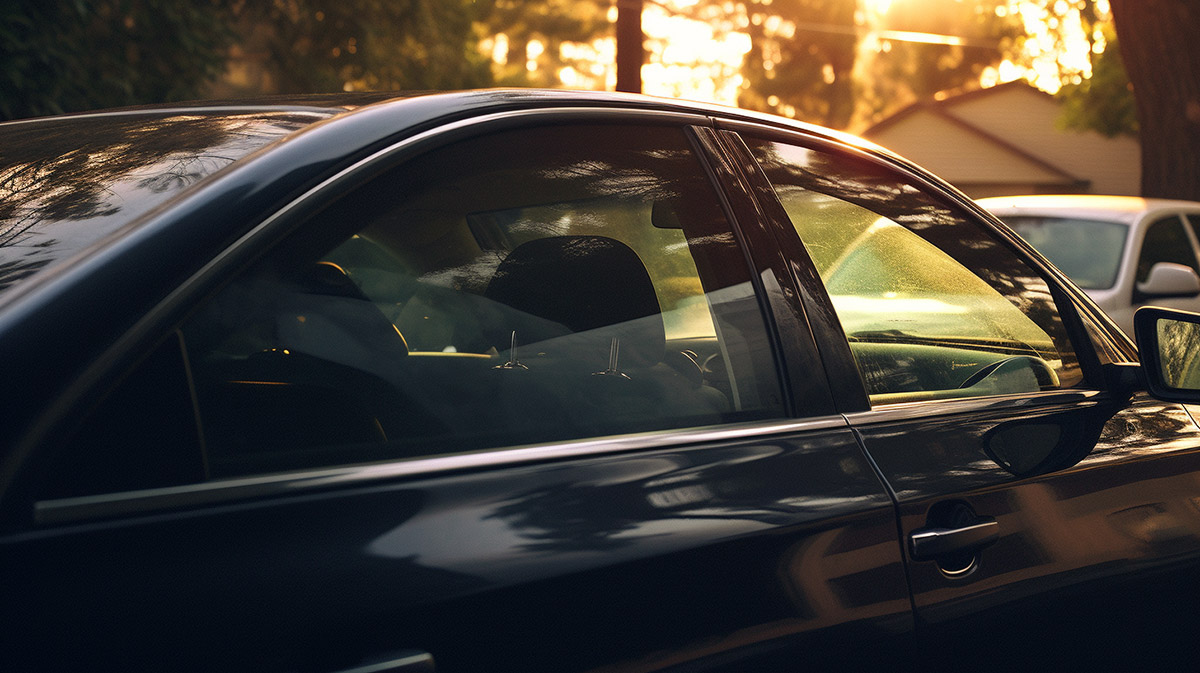
You should wait 48 hours before rolling down your windows after a window tint installation. After 48 hours the top and bottom edges of the window tint will be dry and won’t peel when the window moves.
It’s important to note that the exact timeframe may vary based on factors such as the type of tint used — from standard to ceramic tints — temperature and humidity levels, and the curing time for the adhesive solution used during the tinting process.
Window tinting involves applying a thin laminate film to the glass surface, which is adhered with a special kind of glue, often a water-based solution. This adhesive needs time to dry and bond firmly to the window. Rolling down the window prematurely could interfere with this process, leading to a subpar result. It’s akin to cleaning a freshly painted wall – too soon, and it messes up the finish.
During warmer periods, when the sun is out and heating things up, the drying time may be closer to the lower end of this range. In contrast, in cooler or more humid climates, it could take up to a week. It is always a safe bet to follow the specific recommendations provided by tinting professionals like EverClear Window Tinting or the manufacturer’s instructions if you opt for a DIY installation.
What Happens if I Accidentally Roll My Window Down After a Tint Installation?
Accidentally rolling down your windows too soon after a tint installation can cause a range of problems. Primarily, it can lead to the formation of bubbles or wrinkles in the film. This happens because the tint adhesive, which can be a water-based solution, has not fully dried and hardened, causing it to move or warp when the window is lowered.
Moreover, the top edge of the tint, which is usually carefully aligned with the window’s top, might peel away or get damaged if the window is rolled down prematurely. This could lead to an uneven or jagged edge that not only looks unsightly but also exposes the edge of the film to further peeling in the future.
As an extra incentive to prevent this, consider this, in the worst-case scenario, the entire tint job may need to be redone if the tint is significantly damaged. This can result in added cost and time, so it’s crucial to remember to keep those windows up for the first few days after the tint installation.
Does Tint Get Darker After a Few Days?
There is a common misconception that tint changes colour or gets darker after a few days. The fact is, the appearance of the tint does not considerably change once applied to the window. However, it’s worth noting that the tint may appear lighter or darker during the curing process.
This happens due to the moisture used during the application, which remains between the window and the film until fully dried. As this moisture evaporates during the drying process, it might give the illusion of the tint lightening or darkening. Once fully dried, the tint will return to its original colour, providing the look and privacy you desired, as well as ultraviolet protection to shield your car’s interior.
How Can I Make My Tint Dry Faster?
While patience is certainly a virtue when it comes to waiting for window tint to dry, there are a few methods you can adopt to expedite the drying process. However, these should be followed judiciously to avoid any potential damage to the newly applied tint or your windshield. Here’s what you can do:
Optimal Environment: Try to keep your vehicle in an environment that’s conducive to drying. A warm, dry place is ideal. If possible, leave your car in a sunny spot or a heated garage as warmth accelerates the drying process.
Avoid Excess Water: Keep the interior of the car as dry as possible. Any additional moisture, such as rain or high humidity, can prolong the drying process. If you can, try to schedule your tinting job during a dry season or check the forecast for a few dry days post-application.
Do Not Interfere: As tempting as it may be, do not try to speed up the process by using a heater, hairdryer, or any other artificial heat source directly on the windows. This could cause the adhesive solution to dry unevenly and lead to bubbles or peeling.
Ventilate the Car: When you’re driving the car after tinting, use the vehicle’s ventilation system to circulate air, but make sure not to direct air flow onto the windows. This can help in reducing the overall moisture levels inside the car.
Remember, even with these tips, it’s important to give your window tint sufficient time to dry thoroughly. The quality and durability of your tint are largely dependent on the drying process. Rushing through it may only compromise the finish and lifespan of your tint, which is meant to protect your car’s interior from the sun’s ultraviolet rays, among other things. Always consult with your tinting professional for advice specific to your circumstances.

